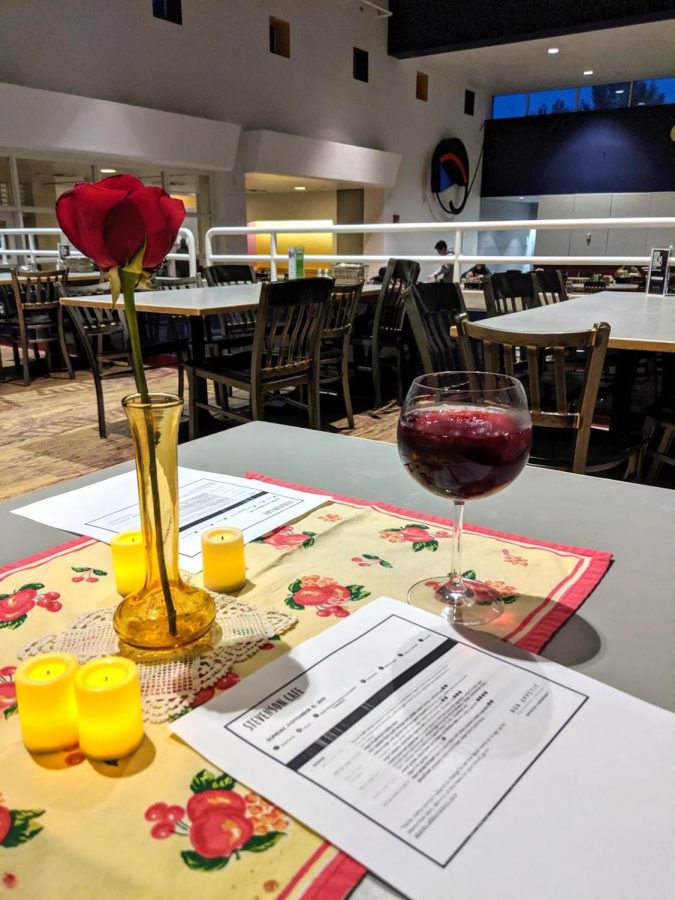Student Dining Innovations Improve Social Atmosphere
A table set for a Stevie Dinner Date.
Last week, a waiter sat College fourth-year Monica Dix and I at a corner table at Stevenson Dining Hall. That waiter was College fourth-year Jody Shanabrook, the founder and sole waitstaff of the Stevie Dinner Date Service, a pop-up restaurant-style dining experience available for a $5 service fee. For another $5, our dinner could have been accompanied by College fourth-year Riley Calcagno’s live violin music.
“We’ve had five bookings over the past two weeks, but our business has been exploding recently, with new services to fit more diverse booking requests on the way,” Shanabrook said.
Our Stevie table was transformed from a regular cafeteria table to a fine dining space with a tangerine-print tablecloth, four flickering electric candles, cloth napkins, a single rose, and wide-brimmed wine glasses, all pulled from Shanabrook’s satchel. The first official Stevie Dinner Date had just begun.
Shanabrook’s newest service is only the latest of many student-run experiments inside Stevie to make the space, often criticized as being massive and bleak, more intimate and lively. This year, the dining staff is working to make all meals, especially those in Stevie, more engaging by developing a new dining master plan.
As Shanabrook fetched our drinks — chamomile tea with lemon and chilled grape juice — I thought back to all of the dining hall projects that students have spearheaded during my four years as a dining committee member. One such trend was experimenting with a classic form of food improv. When Claire Abramovitz, OC ’19, was a first-year student, she ran “Stevie Chopped,” an underground food contest in which she judged dishes like vegan faux-sushi and balsamic ice cream — which she called blasphemous.
After we finished a well-plated salad of arugula, snap peas, and herb vinaigrette that Shanabrook served us, he asked if he could make us a charcuterie plate, and soon returned with toasted bread, hummus, olives, cheese, and a pickle. Food “hacks” like this are always fun to discover; encountering them is like having a new part of the menu to explore.
However, it is crucial that these hacks don’t impede Stevie workers. Last month, food columnists in the Review recommended that you can “use the waffle machines in Stevie to create any delicacy under the sun” (“New Food Columnists Rate Dining Hall Desserts,” The Oberlin Review, October 4, 2019). This kind of Stevie improvisation is frowned upon by campus dining workers, given the difficulty of cleaning waffle machines with chocolate or cheese inside, as well as the possibility of allergic reactions for others who use the machines. However, this doesn’t mean Stevie management is averse to all types of food hack fun.
Although numerous Stevie Instagram accounts have existed to document everything from Stevie’s oranges to its depression meals, this Saturday, a new social media account is going live: @hackstevenson. CDS Assistant General Manager Bill Bolton created the account to promote the food hacks students have been trying for years. Now, a prize of $50 will be given to whoever submits the food hack that gets the most likes. The account will take direct message entries, and Shanabrook’s charcuterie plate has a chance to win. When the CDS administration discovered Shanabrook’s dinner date idea a few weeks ago, they responded with laughs and more questions about the service.
“It’s pretty slick, man,” Bolton later said.
In November, Warren Bulseco, senior principal architect with WTW Architects, came to Oberlin to conduct a student forum on the dining master plan where he announced three possibilities to retrofit Stevie. All of the plans turn the first and second floors of the dining hall into a space for eating, studying, and group activities by removing the first floor offices. Although architectural planning and development will take time and resources, CDS is aiming for more social opportunities included with dining.
“To me, a more social Stevenson has places to congregate but not be in a cafeteria, where you can sit with a group but not with every other group around you,” Bolton said.
Additionally, he wants the experience to be a bit more fun for all involved.
“It kills me that there’s no music upstairs,” he said. “I hope to get music in the servery over Winter Term, but that’s not long term.”
Most large-scale adjustments to Stevie can be expected over the summer of 2020 at the earliest. Until then, if someone wants to hear live music, consider Calcagno’s $5 surcharge for dinner date fiddle music. And if you’d like, sign up for a dinner date to try what CDS Office Manager Kathy Mueller calls Shanabrook’s project: an example of the student body’s “entrepreneurial spirit” and “creativity.”










